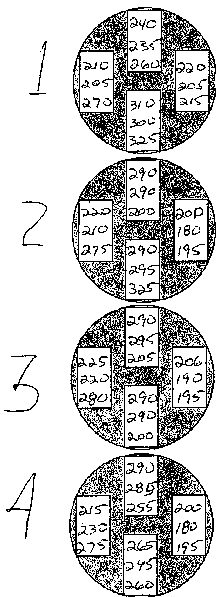 The image on the right depicts the sonic test data for Jim Butterworth's 2.3L S14 cylinder block.
Note that although the individual thickness values are different, the trends in thickness are
the same as for my block on the previous page.
Click here
to see a side-by-side comparison of both sets of results.
The image on the right depicts the sonic test data for Jim Butterworth's 2.3L S14 cylinder block.
Note that although the individual thickness values are different, the trends in thickness are
the same as for my block on the previous page.
Click here
to see a side-by-side comparison of both sets of results.
Now we should think about how the thickness of the cylinder walls affects block integrity and overall performance. I do not have a lot of experience trying different bore sizes on the S14 block. But I have read everything I could get my hands on regarding bottom end rebuilds. I have also spoken with anyone that would listen regarding cyl. wall thickness. It seems that in the world of U.S. V8 performance (engines putting out 600 HP and up), the general consensus is that the minimum cylinder wall thickness should be above 0.180" - 0.200". In the world of smaller 4 cylinder performance engines (in the region of 1.8 - 2.5 liters) people seem to be happy with 0.140" - 0.160". I've got VW friends who have taken it down to 0.100" without any problems (yet) but that seems extreme. But where is the thickness most important? Certainly it is important in the region between the cylinder bores. If for no other reason than that there must be sufficient area for the head gasket between the cylinders. If this area is made too small then it may lead the gasket to blow out a small hole between the cylinders which leads to cross-talk (I've experienced this on my old 16V Rabbit and it was a bear to diagnose). On the S14 block the bores are Siamese'd, which means that the cylinder liners touch each other - there is no space in between the cylinder liners for coolant to flow. This is done to increase the strength of the block, the areas where the cylinder liners touch form "mini-bulkheads". The remaining portions of the cylinder liners do little to strengthen the block in my opinion. A look at an S14 makes it pretty obvious that the strength of the block comes from the relatively thick outer walls, not the thinner cylinder liners. And in any case, the S14 block was designed to handle a lot of power. Things like "block flex" are probably not an issue at the power levels most of us will achieve. But this does not mean that the cylinder liners can be made paper thin. The liners must still contain the pressures of combustion. And also, as the pistons move down on the expansion stroke they exert a force on the passenger side of the cylinder wall. And this force is proportional to rod angularity. Thus on big stroke engines the side loading on the cyl. walls is increased. So on a 92mm stroke 2.6L engine one might want to play it conservatively with the thickness of the cylinder liners. Unfortunately, in this regard the 2.3L S14 block appears to be thinnest on the passenger side of the #3 and #4 cylinder walls. This area is probably the limiting situation in determining how far one can go when over-boring the block. Going to 95 mm would leave these regions at around 0.130" - 0.140". This is at the limit of what most 4 cylinder tuners find acceptable, but luckily it is only over a small area. Going too large in this region might lead to bore distortion during the expansion stroke. This can cause blow-by (and an associated loss in power) and it can also cause premature wear due to piston scuffing. |
|
Ultimately when deciding how big to go with an over-bore; "You pay your money and you take your chances". |